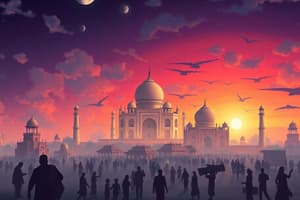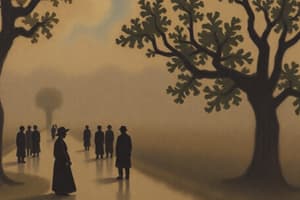Podcast
Questions and Answers
What is a census?
What is a census?
- A measure of the average rainfall in a country
- A count of animal species in a region
- An estimate of the number of trees in a forest
- A periodic official count of the population with social and economic information (correct)
Which of these options accounts for 17.5% of the total world population?
Which of these options accounts for 17.5% of the total world population?
- USA
- Brazil
- India (correct)
- China
Under which ministry is the Registrar General and Census Commissioner of India?
Under which ministry is the Registrar General and Census Commissioner of India?
- Ministry of Finance
- Ministry of Statistics and Programme Implementation
- Ministry of External Affairs
- Ministry of Home Affairs (correct)
Who was the first Census Commissioner of India?
Who was the first Census Commissioner of India?
How often is the census conducted in India?
How often is the census conducted in India?
What is the primary purpose of the NPR (National Population Register)?
What is the primary purpose of the NPR (National Population Register)?
In which year was the NPR first collected?
In which year was the NPR first collected?
Who was the first woman to get UID(Aadhaar number)?
Who was the first woman to get UID(Aadhaar number)?
Who was the last Census Commissioner of India before 1949?
Who was the last Census Commissioner of India before 1949?
Where did the UID project started?
Where did the UID project started?
Flashcards
What is a Census?
What is a Census?
A periodic official count of the population, including social and economic information.
Ancient Census Mentions?
Ancient Census Mentions?
The Rig-Veda and Kautilya's Arthashastra.
India's Population Share
India's Population Share
India accounts for 17.5% of the total world population.
First Census Commissioner of India
First Census Commissioner of India
Signup and view all the flashcards
Who conducts census since 1949?
Who conducts census since 1949?
Signup and view all the flashcards
NPR (National Population Register)
NPR (National Population Register)
Signup and view all the flashcards
2010
2010
Signup and view all the flashcards
M.W.M. Yates (1941-49)
M.W.M. Yates (1941-49)
Signup and view all the flashcards
Shri Mrityunjay Kumar Narayan
Shri Mrityunjay Kumar Narayan
Signup and view all the flashcards
Tembali village
Tembali village
Signup and view all the flashcards
Study Notes
- The economic development of a country depends on human and natural resources, as human resources define population, a key part of economic growth.
- Demography studies population size, structure, and development.
- Population refers to the total number of people or organisms in a given area.
Population Characteristics
- Characteristics include growth pattern, population density, and regulation.
- Sex ratio, death rate, birth rate, spread, and population density are all related to characteristics.
Census Definition and Purpose
- A census involves a periodic official count of the population, incorporating social and economic information.
- The census assesses planned development and demographic changes.
- The Demographic Transition theory suggests high birth and death rates.
- National census excludes ethnic groups but includes religious, tribal, and scheduled caste populations.
History of the Census in India
- The Indian Census provides statistical information on the population's characteristics.
- The Rig Veda and Kautilya's Arthashastra mention population counts.
- Conducted for over 130 years, proving data every 10 years.
- The census began in 1872 during Lord Mayo's tenure, though unsynchronized.
- India's first synchronous census occurred in 1881 under Lord Ripon and now done every 10 years.
- Population census is a Union subject under the 7th schedule of Article 246.
- India is the second most populous country after China; the 2011 population was 1.21 billion (121 crore).
- India accounts for 17.5% of the world population.
Key Figures and Institutions
- W.C. Plowden (1881) was India's first Census Commissioner.
- Since 1949, the Registrar General and Census Commissioner of India conducts the census under the Home Affairs Ministry.
- Shri M.W.M. Yates (1941-49) was the last Census Commissioner and the first Registrar General and Census Commissioner.
- Shri Mrityunjay Kumar Narayan is the present Registrar General and Census Commissioner of India (2022).
World Population Day
- World Population Day on July 11, started in 1988 by the UNFPA, which used July 11, 1987 as a base.
- In 2023, the theme "Unleashing the power of gender equality: Uplifting the voices of women and girls to unlock our world's infinite possibilities".
Population Policies and Registers
- Population Policy 2000 was influenced from the M.S. Swaminathan Committee.
- 2045 is the target year for population stability, according to the National Population Policy 2000.
- The National Population Register (NPR) contains a list of residents for identity database purposes, first collected in 2010 and updated in 2015.
National Register of Citizens (NRC)
- NRC is a register showing houses or holdings in serial order, with residents' details after the Census of 1951.
- Published only once in 1951, NRC has not been updated recently.
- India's first census after independence was in 1951.
- Census is legally supported by the Census Act, 1948.
Aadhaar Scheme
- UIDAI issues twelve-digit Aadhaar numbers to residents in India.
- Ten fingerprints and iris scans issue an Aadhaar number.
- Tembali village in Maharashtra, India's first Aadhaar village, started the UID project..
- Ranjana Sonawane, a tribal woman, was the first to get a UID, which makes this the world's largest IT project.
Census Timeline and Growth Periods
- Fifteen population censuses have been conducted so far.
- Eight censuses conducted before independence while seven have been conducted after independence.
- Growth Period breakdown:
- 1881-1921 – Normal Growth Period
- 1921-1951 – Medium Growth Period
- 1951 to present – Fast Growth Period
- The census of 1921 had a 0.31% negative growth rate, the only instance in India’s demographic history.
- 1921 is deemed the Demographic Divide due to the negative percentage.
- Population growth rate is equal to the difference between birth and death rates.
- The period 1901-1921 is referred to as the 'Period of stationary phase' of India's population.
- A major contributor to population increase in India is a high birth rate and falling death rate.
- The period from 1951 to 1981 is deemed the "Era of population Explosion".
- India's annual growth rate began declining steadily in 1981.
- The growth rate during 2001-2011 was the sharpest decline since independence.
- Caste details were counted after 1931.
Census 2011
- Census 2011 was the 15th national census survey by the Census Organization of India, with C. Chandramouli as the Commissioner & Registrar General.
- Conducted in two phases: house listing and population enumeration.
- The census covered 28 states and 7 Union Territories, with 640 districts, 497 cities, 5767 tehsils, and over 6 lakh villages.
- The Indian Population Census 2011 covered many parameters like population characteristics, growth rate, literacy, density, sex ratio, and child sex ratio (0-6 years).
- As per Census 2011, the population was 1,210,854,977, including 623,724,248 males and 586,469,174 females.
- The country's literacy rate is 74.04%.
- The population density is 382 persons per square km.
- The sex ratio shows 943 females per 1000 males.
- The child sex ratio is 919 females per 1000 males.
- Provisional reports released on March 31st, 2011.
- Transgender individuals were included like "others".
- Inclusion of tribes from Andaman and Nicobar islands in the census.
- Data was published on January 7 January 2014.
- Female Enumerator acted as the mascot.
- The census used the motto "Our Census, Our Future.”
- The Census urban-rural ratio was 31:69 in 2011.
- Urban males had greater rates of literacy.
- India's level of urbanization is the percentage of urban populace with the total population.
- State-level insights: - Goa has the highest urban population percentage. - Himachal Pradesh has the highest rural population percentage.
Rural and Urban Populations (2011)
- 31.16% of people in India live in urban areas, as of 2011.
- Urban populations are high in Goa, Mizoram, and Tamil Nadu.
- Rural populations are high in Himachal Pradesh, Bihar, and Assam.
- In 2011, the number of people in rural areas was 68.84%.
- Union Territories insights:
- Delhi is mostly urban.
- Himachal Pradesh is mostly rural.
- Maximum population:
- Uttar Pradesh (UP) has the maximum population
- Minimum population: - Lakshadweep has the minimum population.
- In 2011, approximately 20.9% were aged adolescents (10-19 years) in India.
- Telangana’s formation shifted Andhra Pradesh, Madhya Pradesh, and Rajasthan down in their total population rankings.
- Of the total population the highest number of inhabited villages are in Bihar and it has the maximum fertility rate.
- The descending order of the total population are Maharashtra, Bihar, and West Bengal.
- The highest populated district is Thane in Mumbai.
- The lowest populated district is Dibang Valley, Arunachal Pradesh.
- Minimum population is concentrated in the State/Union territories of:
- Sikkim
- Lakshadweep
- Maximum decadal population growth is concentrated in the State/Union territories of:
- Dadra and Nagar Haveli
- Minimum population is concentrated in the State/Union territories of:
- Nagaland
- Kerala
- Population declines in Nagaland during the decade 2001-2011, making it unique.
- Regarding metro cities in 2011: - Mumbai - Delhi - Kolkata
- Population density represents people per square km.
- In 1951 population density of India was 117 persons per sq km and in 2011 it increased up to 382 persons per sq km.
- The sex ratio, referring to the number of women per 1000 men, was shown to be 943 for the year 2011.
- Bihar has the highest population density and Arunachal Pradesh has the lowest.
- Of the total population:
- Bihar concentrates the highest population density.
- As compared to the other States/Union territories, Delhi concentrates the highest area of urban population.
- Considering just Union Territories:
- Dadra and Nagar concentrate the highest population area
- Lakshadweep concentrate the most area of the lowest. The states and Union Territories with the largest sex ratios are:
- Kerala
- Pondicherry
- The state and Union Territory with the lowest sex ratios are:
- Haryana
- Daman and Diu
- With regards to the children population, Arunachal Pradesh has the highest sex-ratio whereas Haryana has the lowest.
- In 2011, the child sex ratio was 919, as compared to 927 in 2001.
- In the total population, Kerala has the highest sex ratio and Haryana has the lowest.
- The State territory and district with the maximum sex-ratio are:
- Kerala
- Mahe (Pondicherry)
- The State territory and district with the minimum sex-ratio are:
- Daman and Diu.
Literacy Rate Insights
- The literacy rate, the proportion of people (7 years and above) who can read, write, and understand any language, was 74.04%.
- The 2011 rate among the Indian population was 74.04%, with male literacy at 82.14% and female literacy at 65.46%.
- There is a 16.68% difference between the literacy rates of male and female whereas there is an 8.58% difference against total literacy.
- From 2001 to 2011 the literacy rate in India has increased at an average of 9.21%.
- The 2011 census showed Kerala has the highest literacy, whereas Bihar is at the bottom.
- In 1981, there was the largest difference in the rates between literacy in the nation.
- Regarding the scheduled tribes:
- Highest literacy concentration is in Mizoram.
- Lowest literacy concentration is in Andhra Pradesh.
- Kerala had a sex ratio of 1084 and Pondicherry has a minimum sex ratio.
- Mizoram had a 91.33% literacy rate.
- According to list: - The population of Hindus was 78.80%. - Muslims were 14.23% - India had a 2.3% population of Christians, 1.72% of Sikhs, 0.70% Buddhist State. - Jain was seen at ~0.37, 2.06% belonged to other groups.
- Himachal Pradesh, with 95.24% of the total population, is the highest Hindu State followed by Lakshadweep.
- As of statistics, Christianity displays the highest sex ratio i.e. is 1009 whereas for Sikhs the ratio is the lowest i.e. is 893.
- Meghalaya showed a 27.62% increase in the Meghalaya state and among U.Ts. Daman and Diu ranked first.
- In the 2011 statistics among Union, Delhi had a maximum population of scheduled castes.
The key highpoints for Scheduled Castes & Tribes are:
- Total Scheduled Castes: 20.13 crore.
- Total Schedule Tribe: 10.42 crore.
Analysis of Census and Fertility Rates
- As per the 2011 survey:
- 43.63% of India population can speak Hindi.
- 8.05% population Bengali.
- In India's southern part, Tamil is the top known Language with 5.70%.
- Scheduled Castes
- In the list for maximum percentage wise for scheduled castes the place goes to Punjab i.e. is 31.9% followed by Mizoram which records to as low as 0.1%.
- Among U.T. with ~31% Chandigarh tops with maximum and Dadra and Nagar records the lowest among.
- Scheduled Tribes showed similar pattern:
- Mizoram showed ~94% - Highest.
- Rest of other states ranged from ~80 to as low as other states.
- Very less Schedule Tribe population in U. Ts in comparison. The Scheduled Castes Sex Ratio is displayed as 945 and as per reportings, Kerala records to be 1057 and whereas Mizoram records to be at 509.
Other Reports
- In census reports
- The number for India's schedule caste population is 66.1% and of the number 92.4% shows literacy and whereas the minimum records 48%. Among the total area of the population, the Sex Ratio in S.Ts reported at 990 and Kerala recorded at 1046 whereas J & K reported least (924) i.e. a lowest ratio. •Lakshadweep:
- With a total of State area (94%), it showed literacy and literacy-wise. Population in State vice: With highest population the name state is Mizoram. With a minimum number state is UP.
- At State level i.e is at top Gujarat and Rajasthan is higher side (93-70) in range.
- India shows a record number of missing women i.e. above 45 million numbers which affects at gender ratios (Report for the report World of population in 2020 based.)
- Human Development:
Reported that at 68+ are above a standard number to above the rest in the birth. More reports as over:
- The Human density population as over 3 times than the number of population. Very least reportings over and with minimum numbers, there is report like a top as for population.
- Among states the richest city, the names are as like the very famous are Mumbai to 89 and more like.
- Report analysis: 1. It is said that India has less numbers in comparison reports and other details whereas they says there is increase number of women in India in comparison reports and other areas they display reports the other way that they has better understanding compared to various reports. 2. 9.6% has unemployment and poverty is recorded at 37 % of total population. 3. Fertility is over a score near 3 and lowest number is Sikkim with 1 +
- As a list of comparison the areas around India:
- India is near 2 position when about its near area of side state by China. 2. Top State where people’s is populated for Maharashtra to West and and the state with the highest Population for States is in the form State, India. 3. Is reported for areas of most population in India but with state where top city that has the highest city areas of density. 4. and the district with the least count among its population records show high literacy details than India does in total. Report details in all census details done above.
- According to Census 01-11 time: • The data of growth shows 2% on average and shows to reports of the time. In all States: 1. Has lowest number when among State: Is with higher number but in comparison very the least. Report shows has number better than other number population. 2. More than 3 x the has population but is also the State for number population as reported
Studying That Suits You
Use AI to generate personalized quizzes and flashcards to suit your learning preferences.




